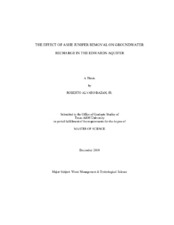| dc.description.abstract | Understanding groundwater recharge rates has direct relevance for management of the Edwards Aquifer, which serves as the main source of fresh water for the city of San Antonio and surrounding communities. As population around San Antonio continues to grow, so does the demand for water and the stress placed on the aquifer. A method that is commonly believed to augment water yields is brush management. Over the last 150 years an increase in juniper density on the Edwards Plateau has coincided with decreasing streamflow. This has led many to believe that removing juniper would increase available water. Due to its karstic nature, the recharge zone of the Edwards Aquifer is assumed to be a prime location for augmenting water yields through vegetation manipulation.
This study assesses the dynamics of recharge and the effects of manipulating surface vegetation. To accomplish this, a shallow cave located in the Edwards Aquifer recharge zone in San Antonio, Texas was instrumented to monitor drip recharge in response to simulated rainfall events. In 2004, simulations were conducted over the cave to measure recharge rates with a dense Ashe juniper canopy. The data and observations from the initial simulations were used to establish a baseline with the juniper in place. In February 2008 the juniper stand was cleared and the rainfall simulations were reproduced in June and July 2008, and again in early June 2009. Results from the study indicated that even though the amount of rainfall reaching the surface increased, a decrease in the amount of recharge occurred. The decrease can be possibly be explained by the elimination of stemflow, which is believed to direct higher concentrations of water to preferential flow paths near the base of the tree, and an increase in surface runoff. However, because such a large portion of the water reaching the surface is not accounted for by the budget, it is difficult to conclude that a change in recharge did not occur at a larger scale. | en |


